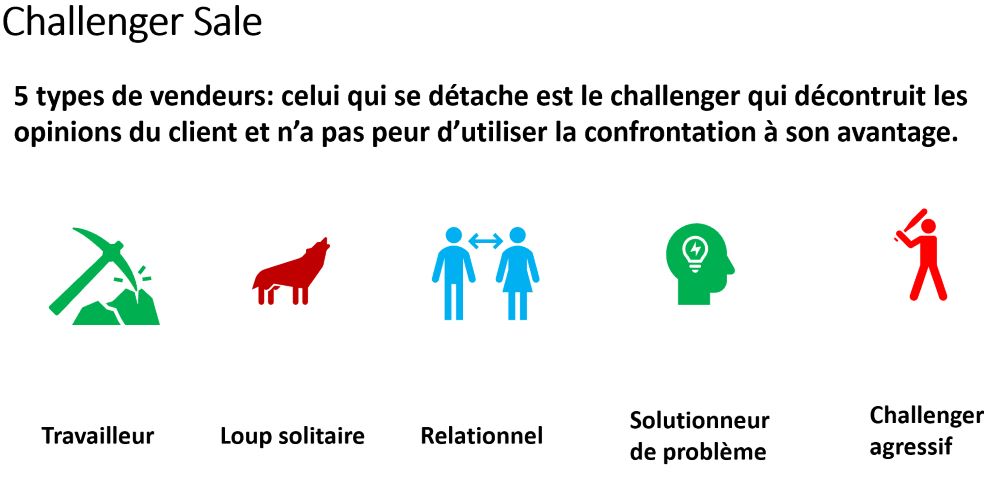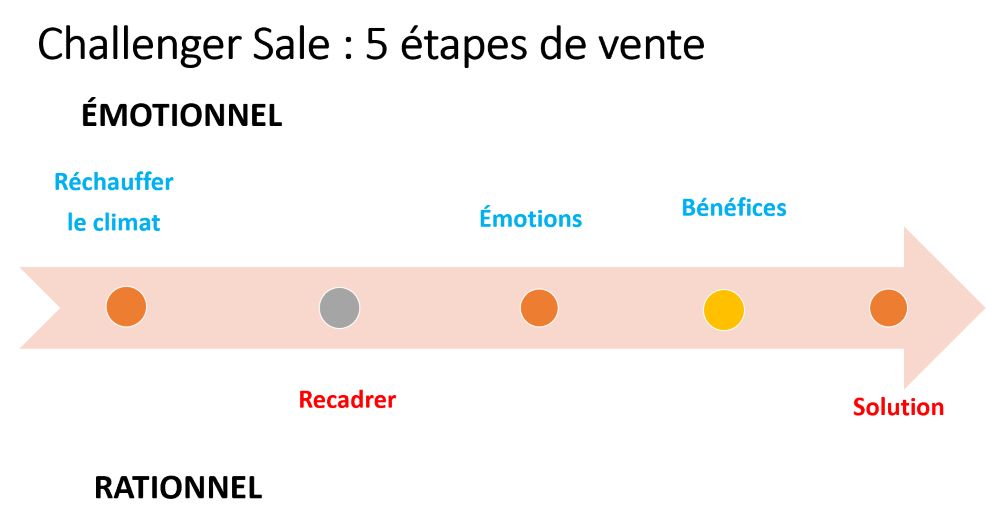Challenger Sale – sales techniques
The Challenger Sale technique, developed by the Americans Dixon and Adamson, is currently the most talked-about. They believe that selling is getting tougher and tougher in today’s world, and that some salespeople, the challengers, are doing much better than the average person, and proceeding in a different way, not afraid to challenge their customer. The […]
The Challenger Sale technique, developed by the Americans Dixon and Adamson, is currently the most talked-about. They believe that selling is getting tougher and tougher in today’s world, and that some salespeople, the challengers, are doing much better than the average person, and proceeding in a different way, not afraid to challenge their customer.
The three key principles are :
- Customer training
- Adapting sales
- Taking control of the meeting
The different types of salespeople
Dixon and Adamson identify five salesperson profiles, including one that performs well above average:
- The worker will always do a little more than the others, starts early in the morning, finishes late at night, is diligent, organized, responds to all customer requests.
- Relational people like contact, like everyone, defend their customers, are generous with their time, and will try to give them as much as possible. He fights to defend his client within his own organization.
- The lone wolf is self-confident and aggressive, afraid of nothing and attacking whenever he can. He dislikes hierarchy and organizational constraints. He has his own methods, avoids sales training and doesn’t listen at meetings.
- The problem solver is responsive, intelligent, serious and perceptive, always on hand to solve his customers’ problems.
- Challengers have a different view of the world, they don’t hesitate to contradict their customers, provoke debate, and aren’t afraid to deliberately create tension in order to benefit from it. He is self-confident and doesn’t hesitate to express his opinions, both to his customers and to his superiors. He uses confrontation to challenge his customers’ preconceptions.
It’s the challenger who delivers sales results that stand out from other profiles.

The challenger sale process
Dixon and Adamson distinguish five stages.
- Étape 1 : échauffer le climat en discutant des problèmes du client de manière intelligente afin d’assurer sa crédibilité.
- Give the objective of the meeting
- Position yourself as a subject-matter expert
- Arousing the customer’s curiosity
- Providing relevant information
- Étape 2 : recadrer la conversation pour montrer au client que les solutions auxquelles il pensent ne sont pas les bonnes
- Surprise the customer by explaining premise errors
- Be confident in what you say
- Étape 3 : utiliser les émotions en présentant des histoires de clients qui gagnent et des résultats extraordinaires obtenus
- Creating a story
- Presenting testimonials
- Étape 4 : mettre en évidence les bénéfices que le client cherche à long terme
- A positive vision of the future
- Focus on the benefits of the solution
- Étape 5 : proposer la solution une fois que le client est prêt
- Solution technical details
- Implementation schedule

Advantages of challenger sale
- The authors claim that their method has proven its worth
- The description of the best salesperson as a challenger is very common.
- Customer-centric technology
- It’s always a good idea to unsettle the customer’s opinions before putting forward our solutions.
Disadvantages of the challenger sale
- The method is time-consuming, complicated and only suitable for top sellers.
- It only applies to complex sales
- The SOS sales technique achieves the same result, but is simpler and more intuitive.
Challenger Sale: conclusion
Whether you apply the method or not, remember that it’s always a good idea to challenge your customer on the solutions they use. For any complex sale, you also need to record the information you obtain from your customer without a CRM.
Jean-Pierre Mercier
